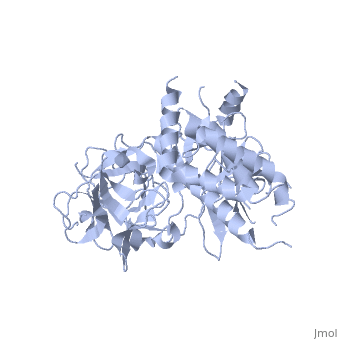2xoa
From Proteopedia
Crystal Structure of the N-terminal three domains of the skeletal muscle Ryanodine Receptor (RyR1)
Structural highlights
FunctionRYR1_RABIT Calcium channel that mediates the release of Ca(2+) from the sarcoplasmic reticulum into the cytoplasm and thereby plays a key role in triggering muscle contraction following depolarization of T-tubules. Repeated very high-level exercise increases the open probability of the channel and leads to Ca(2+) leaking into the cytoplasm. Can also mediate the release of Ca(2+) from intracellular stores in neurons, and may thereby promote prolonged Ca(2+) signaling in the brain. Required for normal embryonic development of muscle fibers and skeletal muscle. Required for normal heart morphogenesis, skin development and ossification during embryogenesis (By similarity).[1] [2] Publication Abstract from PubMedMany physiological events require transient increases in cytosolic Ca(2+) concentrations. Ryanodine receptors (RyRs) are ion channels that govern the release of Ca(2+) from the endoplasmic and sarcoplasmic reticulum. Mutations in RyRs can lead to severe genetic conditions that affect both cardiac and skeletal muscle, but locating the mutated residues in the full-length channel structure has been difficult. Here we show the 2.5 A resolution crystal structure of a region spanning three domains of RyR type 1 (RyR1), encompassing amino acid residues 1-559. The domains interact with each other through a predominantly hydrophilic interface. Docking in RyR1 electron microscopy maps unambiguously places the domains in the cytoplasmic portion of the channel, forming a 240-kDa cytoplasmic vestibule around the four-fold symmetry axis. We pinpoint the exact locations of more than 50 disease-associated mutations in full-length RyR1 and RyR2. The mutations can be classified into three groups: those that destabilize the interfaces between the three amino-terminal domains, disturb the folding of individual domains or affect one of six interfaces with other parts of the receptor. We propose a model whereby the opening of a RyR coincides with allosterically coupled motions within the N-terminal domains. This process can be affected by mutations that target various interfaces within and across subunits. The crystal structure provides a framework to understand the many disease-associated mutations in RyRs that have been studied using functional methods, and will be useful for developing new strategies to modulate RyR function in disease states. The amino-terminal disease hotspot of ryanodine receptors forms a cytoplasmic vestibule.,Tung CC, Lobo PA, Kimlicka L, Van Petegem F Nature. 2010 Nov 3. PMID:21048710[3] From MEDLINE®/PubMed®, a database of the U.S. National Library of Medicine. See AlsoReferences
| ||||||||||||||||||

